Scotland's role in the development of future UK trade arrangements
This paper discusses the role of the Scottish Government, Scottish Parliament and others in the development of future UK trade arrangements, to help ensure that Scotland’s economic and other interests can be protected and enhanced.
Chapter One - Scotland and International Trade
22. This chapter summarises the importance of international trade to the Scottish economy, highlighting the potential effects of leaving the Single Market and the Customs Union on Scotland's trade in goods and services. It also highlights some key differences between Scotland and the UK, which will be important in considering and negotiating trade deals that work to the benefit of the whole of the UK.
23. Scotland's Place in Europe: People, Jobs and Investment [7] presents the latest analysis by the Scottish Government of the implications of leaving the EU. The paper demonstrates that leaving the Single Market and Customs Union could significantly weaken our economy, compared to continued EU membership. It estimates that a World Trade Organization rules scenario would lead to a loss of 8.5% of Gross Domestic Product in Scotland by 2030 – equivalent to a loss of £2,300 a year for each individual. A Free Trade Agreement relationship would mean Scotland's GDP would be 6.1% lower by 2030, equivalent to a loss of around £1,600 a year for each individual. Should the UK remain in the Single Market by participating in the EEA, this impact could be significantly mitigated, with Scottish GDP estimated to be around 2.7% lower, or a loss of around £700 a year for each individual.
24. While there is no direct comparator for the approach proposed by the UK Government in its July 2018 White Paper on the future relationship between the UK and EU [8] , several economic commentators have concluded that the White Paper proposal is more similar in scope to a Free Trade Agreement than an EEA. For example, the National Institute of Economic and Social Research [9] conclude that the trade intensity of the White Paper proposals is more comparable to the existing EU-Swiss or EU-Canada relationship than a Norway Style EEA arrangement. Similarly, Professor Jonathan Portes [10] has argued that, under a 'White Paper' scenario, trade in goods could be deemed to be free of both tariff and non-tariff barriers, while trade in services could be viewed as equivalent to an FTA scenario. Consequently, taking into account the likely fall in migration, and reduction in productivity and Foreign Direct Investment, the economic impact of the UK Government White Paper proposal is therefore likely to be closer to the FTA than EEA scenarios modelled in Scotland's Place in Europe: People, Jobs and Investment, implying that the economic impact is likely to be closer to a loss of 6.1% of GDP by 2030 ( FTA scenario) than a loss of 2.7% of GDP by 2030 ( EEA scenario).
25. The EU is the largest single market for Scotland's international exports, with exports worth £12.7 billion in 2016 supporting directly and indirectly hundreds of thousands of jobs across Scotland. This represents 43% of total international exports, and more than exports to North America, Asia, South America and the Middle East combined [11] .
26. The Scottish Government publication, Export Statistics Scotland 2016 [12] , showed that six of Scotland's top ten export destinations are in the EU, emphasising the importance of the future economic relationship with the EU post Brexit. A further two – Norway and Switzerland – are members of the European Free Trade Association ( EFTA), with whom the UK may need to negotiate after Brexit. Other countries with trade agreements with the EU are becoming increasingly important destinations for Scottish exports. For example, Scotland's exports to South Korea – whose agreement with the EU has been provisionally applied since July 2011 [13] - were worth £435 million in 2016, 67% more than in 2012, making South Korea one of Scotland's fastest growing markets, and now the 20 th most important destination for Scottish exports [14] .
Table 1: Top 20 Export Destinations, 2016 (£million)
| Rank | Destination | Total Exports (£m) | % of Total | Rank | Destination | Total Exports (£m) | % of Total |
|---|---|---|---|---|---|---|---|
| 1 | USA | 4,775 | 16.0 | 11 | Belgium | 760 | 2.5 |
| 2 | Netherlands | 2,115 | 7.1 | 12 | Italy | 715 | 2.4 |
| 3 | France | 1,960 | 6.6 | 13 | UAE | 705 | 2.4 |
| 4 | Germany | 1,910 | 6.4 | 14 | Australia | 650 | 2.0 |
| 5 | Norway | 1,365 | 4.6 | 15 | Canada | 610 | 2.0 |
| 6 | Ireland | 1,025 | 3.4 | 16 | Sweden | 565 | 1.9 |
| 7 | Denmark | 995 | 3.3 | 17 | China | 555 | 1.9 |
| 8 | Spain | 855 | 2.9 | 18 | Singapore | 525 | 1.8 |
| 9 | Switzerland | 795 | 2.7 | 19 | Japan | 460 | 1.5 |
| 10 | Brazil | 770 | 2.6 | 20 | South Korea | 435 | 1.5 |
Source: Exports Statistics Scotland (2018)
Benefits of EU Membership
27. For the Scottish economy, membership of the Single Market has resulted in the removal of formal and informal barriers to trade, ensuring our businesses have unfettered access to a market of over 500 million consumers and the largest single market in the world. After Brexit, the European Single Market will still be around seven times the size of the UK market in terms of population. The progress made by the Single Market in dismantling the obstacles to trade in goods and services has been a key driver of growth and employment in Scotland and across the UK in general.
28. The Single Market has resulted in the elimination of the vast majority of tariffs and technical barriers to trade in goods in the form of divergent national rules and regulations governing the sale of the products which businesses buy from each other as part of international supply chains. It is these non-tariff barriers which represent the main obstacle to trade between the EU and "third" countries outside the EU. If the UK leaves the Single Market, then trade is likely to diminish as UK exports become subject to much more restrictive trade agreements.
29. EU Member States and their businesses also benefit from being part of the EU Customs Union, not least the fact that once goods from outside the EU have entered, they can move freely within the EU. Membership of the EU has enabled firms in Scotland to expand their participation in global supply (or value) chains greatly. These are networks of producers across the world which each contribute inputs, in the form of goods and services, to a production process. Even after allowing for the cost and time spent shipping parts across the world, it can be a more efficient and effective production model for companies to import components from the best sources of supply. For instance, the production of an aircraft wing involves multiple parts crossing many EU borders before the wing and the plane is completed.
30. In developing and negotiating future trade arrangements for the UK, it will be vital to recognise the scale and likely impact on Scottish businesses and the Scottish economy. It will be essential to understand the composition, destination and value of Scottish exports and imports, as well as the complexity of global supply chains through which international trade is increasingly carried out. Issues such as the impact of the application of 'rules of origin' on exported goods, the particular concerns of the 'just in time' production model applied in many industries, as well as the overarching concerns related to regulation and standards post-Brexit, must all be recognised in the Scottish context and steps taken to mitigate them as part of the development of any overall UK deal.
31. The negative impact of leaving the Single Market and the Customs Union will be felt across all sectors of the Scottish economy - in our trade in goods but also in our exports of services to the EU and capacity to attract foreign direct investment. This impact will be significant and damaging. While goods make up the bulk of Scottish trade with the EU, services account for around 75% of Scotland's economic output. Services are also becoming increasingly important to the composition of Scotland's exports. For example, service sector exports to the EU have risen from 22% of total EU exports in 2002 to 33% of total EU exports in 2016 [15] . Presently there are relatively limited regulatory barriers to UK service providers selling their services across the EU. No free trade agreement in the world provides for this degree of freedom of movement of services. According to the latest EY Attractiveness Survey [16] , Scotland attracted record levels of foreign investment in 2017, with a 7% increase in the number of Foreign Direct Investment ( FDI) projects compared to 2016, and double the number of jobs secured as a result of FDI. Three of the top five sources of foreign direct investment are in the European Economic Area ( EEA), meaning that Brexit and the consequent impact on free movement of capital and right of establishment could have significant implications for attracting future FDI into Scotland.
Exports by Sector
32. Leaving the EU, the Single Market and the Customs Union will cause real and significant issues across the Scottish economy. Exports are just one avenue through which firms will be affected, and the impact of Brexit may be felt differently for different goods. Chart 1 shows the five sectors in Scotland with the largest nominal value of EU exports in 2016. The two largest sectors involve the manufacture and export of goods, while the others are all service sector industries. [17]
Chart 1 – Nominal value of exports to the EU by sector (£million)
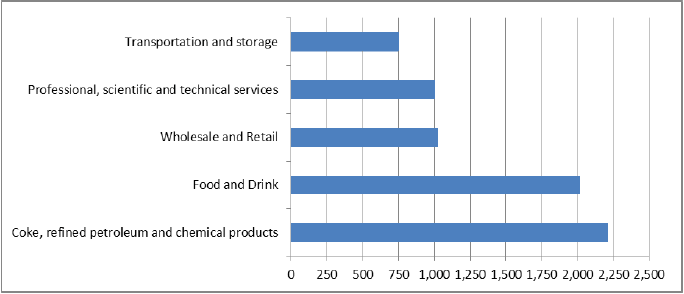
33. The sectors of Scotland's economy most reliant on the EU as a destination for international exports are outlined in Chart 2 below. This chart shows that the EU market accounts for over 60% of exports for five sectors of the Scottish economy (for sectors with a minimum of a total of £400m of international exports). The EU is particularly important as a destination market for exports from the coke and refined petroleum sector, accounting for more than 80% of international exports in that sector. Although the food and drink sector is the second largest EU export sector in nominal terms, it is less reliant on the EU, with 37% of exports destined for the EU, in large part reflecting the demand for Scottish spirit products internationally. [18]
Chart 2: EU exports as a share of international exports – top 5 sectors
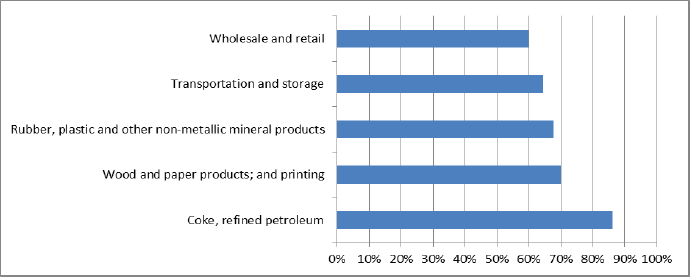
Differences with the UK
34. While there are many similarities between Scotland and the UK as a whole, there are also some significant differences in terms of the relative importance of various sectors and markets. Chart 3 shows the relative importance of particular sectors to Scotland and the rest of the UK in terms of their share of EU exports, comparing UK and Scottish data for each of Scotland's ten most important EU export sectors. While there are some similarities, sectors such as beverages (spirits), and fish, crustaceans, molluscs (seafood) for example, are relatively much more important to the Scottish economy than the rest of the UK.
Chart 3: Exports of goods by sector as a share of total EU exports – Scotland and UK (for Scotland's ten most important sectors by value in 2017) [19]
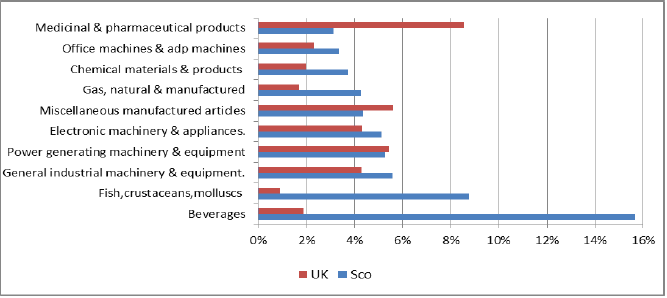
35. Tables 2 and 3 further examine these differences, by comparing the importance of the five most important sectors to Scotland in terms of the value of EU exports to the UK, and vice versa. These tables clearly show that there are some large differences between Scotland and the UK – for example, beverages and seafood are very important to Scotland, and much less so to the UK, while road vehicles, ranking as the most important EU export for the UK, are only the 31 st most important to Scotland.
Table 2 – top 5 Scottish exports to the EU – and UK rank (2017) [20]
| Scotland | UK | ||
|---|---|---|---|
| EU Export Rank | EU Exports (£'000s) | EU Export Rank | |
| Petroleum, & related | 1 | 5,831,842 | 2 |
| Beverages | 2 | 1,297,531 | 19 |
| Fish, crustaceans, molluscs | 3 | 725,260 | 33 |
| General industrial machinery | 4 | 462,005 | 8 |
| Power generating machinery & equipment | 5 | 435,507 | 6 |
Table 3 – top 5 UK exports to EU - and Scottish rank (2017) [21]
| UK | Sco | ||
|---|---|---|---|
| EU Export Rank | EU Exports (£'000s) | EU Export Rank | |
| Road vehicles | 1 | 18,155,935 | 31 |
| Petroleum & related | 2 | 14,704,143 | 1 |
| Medicinal & pharmaceutical products | 3 | 12,718,686 | 11 |
| Other transport equipment | 4 | 8,814,111 | 19 |
| Miscellaneous manufactured articles | 5 | 8,358,099 | 7 |
36. The seafood industry is an important example of a sector where Scotland may have very different considerations from the UK as a whole in negotiating a trade deal. In 2017, 92,000 tonnes of fresh Atlantic salmon worth £600m was exported from the UK (of which 99% was Scottish), representing a 35% increase in value and 26% increase in volume from 2016. The EU is a vital market for Scottish seafood products, accounting for 77% of seafood exports in 2017 and, while the UK as a whole is a net importer of fish, Scotland is a net exporter to the EU and the rest of the world. Disadvantageous non-tariff barriers in particular could have a devastating impact on the export of fresh seafood. [22]
37. Understanding and reflecting these - and other - differences between the UK and Scotland will be important when considering and negotiating trade deals that work to the benefit of the whole UK. Food and drink products, for example, have historically been among the small number of products singled out in trade deals for a less than fully liberalised approach. One of the areas of most importance to the Scottish economy is, based on precedent, therefore likely to be a source of considerable concern when trade deals are being negotiated. Those negotiations will determine the future world trading success of Scotland and the UK. Even within specific sectors, there will often be distinct characteristics to be considered for Scotland including distance from ports and a high dependence on migrant labour.
38. There are also some key differences in the trade in services. Chart 4 below considers the relative importance of service exports by sector as a share of total EU exports, based on ONS regional export data [23] . It shows that, for Scotland, professional, scientific and technical and real estate services account for a much larger share of Scottish service sector exports to the EU compared to Great Britain [24] . Exports of utility-related services are also more important to Scotland, while information and communication exports are relatively much more important to Great Britain.
Chart 4: Services – Share of total EU exports by sector (2015)
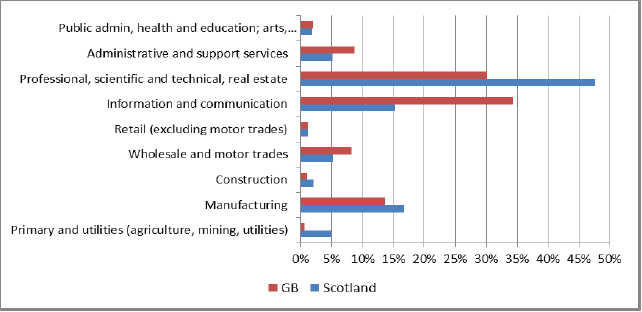
Imports and Value Chains
39. Imports are also a vital part of the trade picture. Allowing cross border flows of goods and services increases the range of goods and services that are available to both businesses and consumers. Openness to imports can also be an important avenue under which competition can be increased, providing incentives for businesses to innovate, in order to improve quality and remain competitive.
40. Imports enable businesses to have access to a cheaper and wider range of raw materials, parts, components and services from multiple countries, allowing them to form global value chains. Such global value chains have become increasingly important in recent decades, increasing competiveness and providing consumers with increased variety and choice. Even after allowing for the cost and time spent shipping materials across the world, it can be a more efficient and effective production model for businesses to import components from the best sources of supply.
41. The benefits of this can equally be felt by the public sector, where the ready availability of cheaper raw materials can have a positive impact on the cost and delivery times of government commitments. The delivery of new homes, for example, can be affected by the supply of timber, tiles and boilers from countries across the EU.
42. In these global value chains, goods and services are exchanged between countries, potentially crossing borders a number of times before being combined and sold as a final product. As a result, any increases in tariffs can become cumulative, and any additional customs requirements can become increasingly burdensome.
43. Import data for Scotland are available for goods sectors but not service sectors. Chart 5 shows the ten goods sectors (taken from HMRC Regional Trade Statistics) in Scotland with the largest nominal value of imports from the EU. The two largest sectors are office machinery and general industrial machinery.
Chart 5 Nominal Value of EU Imports by Sector (For top 10 import sectors from EU), Scotland, 2017 [25]
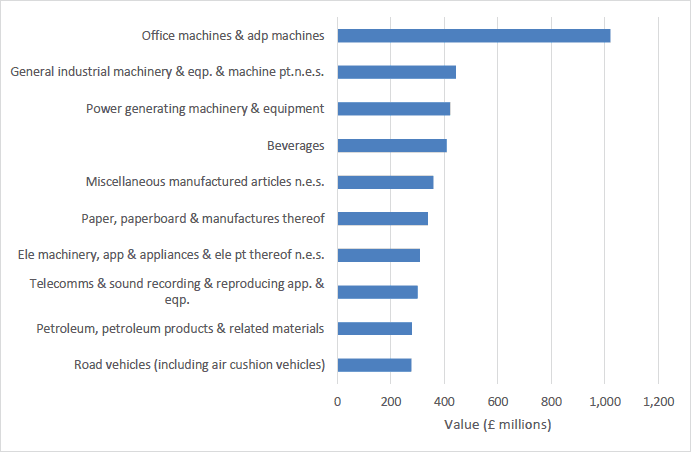
44. The goods sectors of the Scottish economy most reliant on the EU as a source of imports are shown in Chart 6 below. The chart shows that EU imports account for around three quarters of total imports for the papers sector (73%), beverages sectors (78%) and car industry (83%).
Chart 6 EU imports as a percentage of total imports by Sector (for Top 10 import sectors from EU), Scotland, 2017 [26]
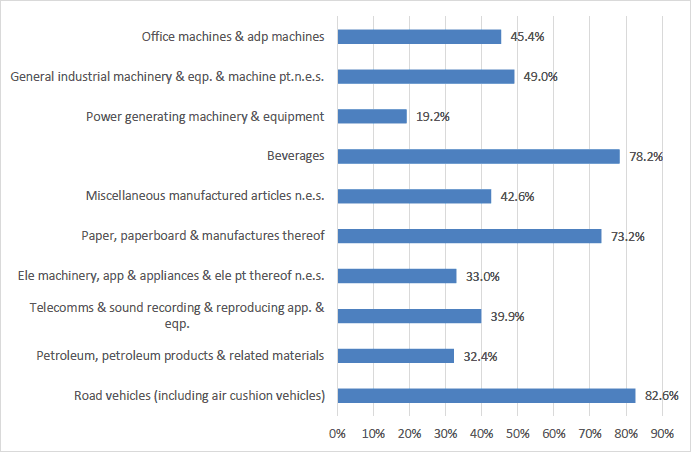
Investment and Productivity
45. Trade integration does not only provide benefits in terms of the flows of goods and services. There is also substantial evidence that trade agreements can help boost investment and can have positive implications for productivity through a number of channels. For example, studies by the Organisation for Economic Co-operation and Development ( OECD) and others shows that, as businesses become increasingly international, they become more competitive and productive [27] .
Contact
There is a problem
Thanks for your feedback